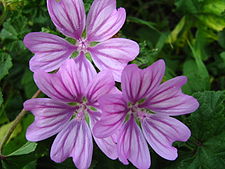- Malvidae
-
?Málvidas
Malva sylvestris (Malvaceae) Clasificación científica Reino: Plantae Clados superiores: Archaeplastida
Viridiplantae
Streptophyta
Streptophytina
Embryophyta
Tracheophyta
Euphyllophyta
Lignophyta
SpermatophytaDivisión: Angiospermae Clase: Eudicotyledoneae Clados y órdenes[2] - Malvidae W.S. Judd, D.E. Soltis & P.S. Soltis.[1]
- orden Brassicales
- orden Crossosomatales
- orden Geraniales
- orden Huerteales
- orden Malvales
- orden Myrtales
- orden Picramniales
- orden Sapindales
- orden Berberidopsidales
- orden Caryophyllales
- orden Santalales
En Nomenclatura filogenética, las málvidas (Malvidae) son un grupo de eudicotiledóneas que habían sido nombradas informalmente como «eurrósidas II» en varios trabajos sobre filogenia de las angiospermas[3] [4] [5] [6] o “malvids”.[7] El nombre eurrósidas II también había sido aplicado de un clado más amplio que incluía a las mirtales.[8] La composición del clado es la siguiente: Brassicales, Crossosomatales, Geraniales, Huerteales, Malvales, Myrtales, Picramniales, Sapindales, Berberidopsidales, Caryophyllales y Santalales.[2]
Referencias
- ↑ Malvidae D.E. Soltis, P.S. Soltis & W.S. Judd. En: P.D. Cantino, J.A. Doyle, S.W. Graham, W. S. Judd, R.G. Olmstead, D. E. Soltis, P.S. Soltis & M.J. Donoghue. 2007. Towards a phylogenetic nomenclature of Tracheophyta. Taxon 56 (3) 822–846
- ↑ a b The Angiosperm Phylogeny Group III ("APG III", en orden alfabético: Brigitta Bremer, Kåre Bremer, Mark W. Chase, Michael F. Fay, James L. Reveal, Douglas E. Soltis, Pamela S. Soltis y Peter F. Stevens, además colaboraron Arne A. Anderberg, Michael J. Moore, Richard G. Olmstead, Paula J. Rudall, Kenneth J. Sytsma, David C. Tank, Kenneth Wurdack, Jenny Q.-Y. Xiang y Sue Zmarzty) (2009). «An update of the Angiosperm Phylogeny Group classification for the orders and families of flowering plants: APG III.» (pdf). Botanical Journal of the Linnean Society (161): pp. 105-121. http://www3.interscience.wiley.com/journal/122630309/abstract.
- ↑ Soltis, D.E., Soltis, P.S., Chase, M.W., Mort, M.E., Albach, D.C., Zanis, M., Savolainen, V., Hahn, W.H., Hoot, S.B., Fay, M.F., Axtell, M., Swensen, S.M., Prince, L.M., Kress, W.J., Nixon, K.C. & Farris, J.S. 2000. Angiosperm phylogeny inferred from 18S rDNA, rbcL, and atpB sequences. Bot. J. Linn. Soc. 133: 381–461.
- ↑ Soltis, D.E., Soltis, P.S., Endress, P.K. & Chase, M.W. 2005. Phylogeny and Evolution of Angiosperms. Sinauer Associates, Sunderland.
- ↑ Judd, W.S., Campbell, C.S., Kellogg, E.A., Stevens, P.F. & Donoghue, M.J. 2002. Plant Systematics—A Phylogenetic Approach, 2nd ed. Sinauer Associates, Sunderland.
- ↑ APG II (Angiosperm Phylogeny Group II). 2003. An update of the Angiosperm Phylogeny Group classification for the orders and families of flowering plants: APG II. Bot. J. Linn. Soc. 141: 399–436.
- ↑ Judd, W.S. & Olmstead, R.G. 2004. A survey of tricolpate (eudicot) phylogenetic relationships. Amer. J. Bot. 91: 1627–1644 ).
- ↑ Savolainen, V., Chase, M.W., Hoot, S.B., Morton, C.M., Soltis, D.E., Bayer, C., Fay, M.F., de Bruijn, A.Y., Sullivan, S. & Qiu, Y.-L. 2000a. Phylogenetics of flowering plants based on combined analysis of plastid atpB and rbcL gene sequences. Syst. Biol. 49: 306–362.
- Malvidae W.S. Judd, D.E. Soltis & P.S. Soltis.[1]
Wikimedia foundation. 2010.

